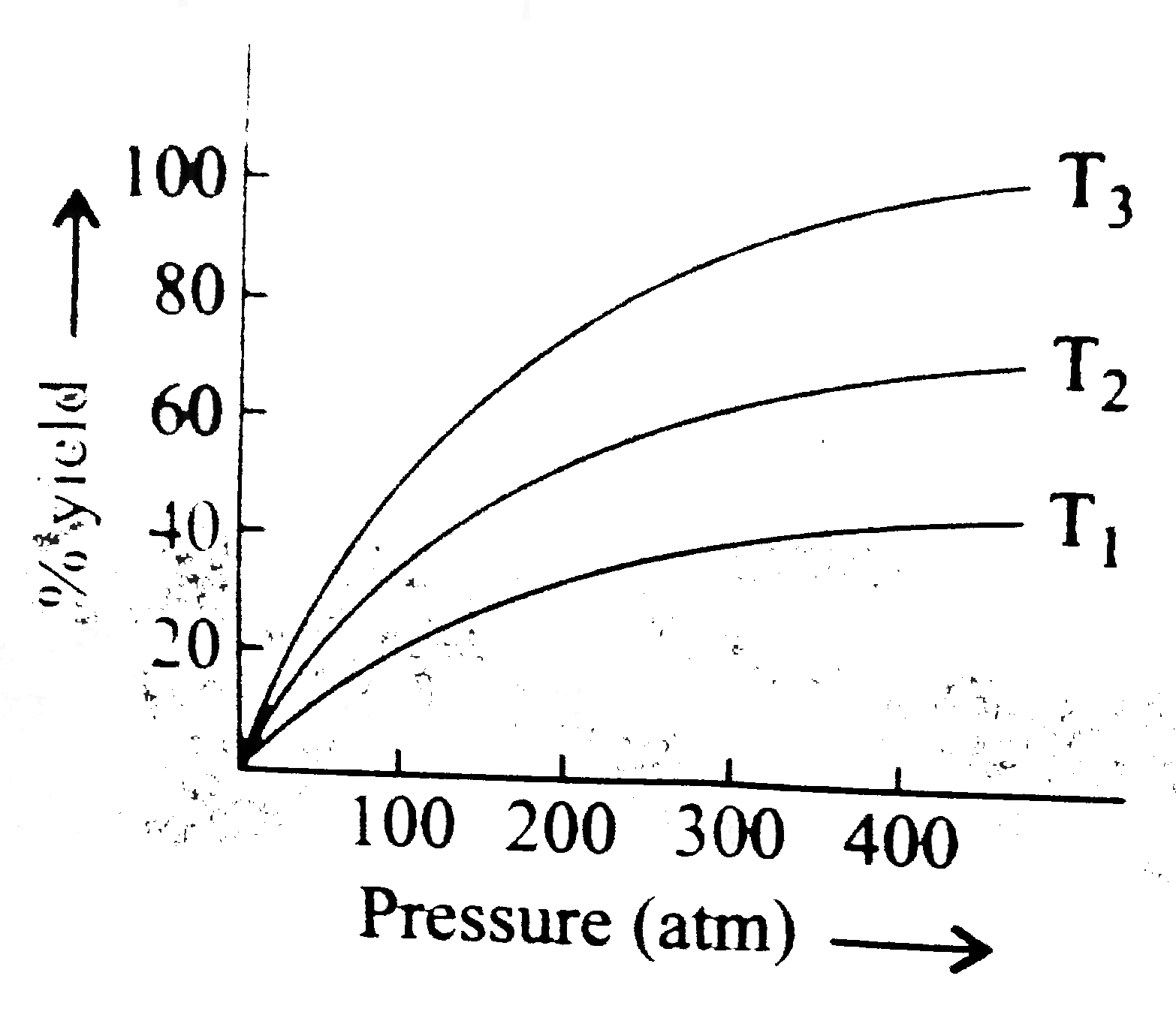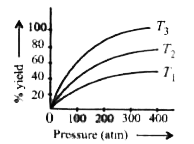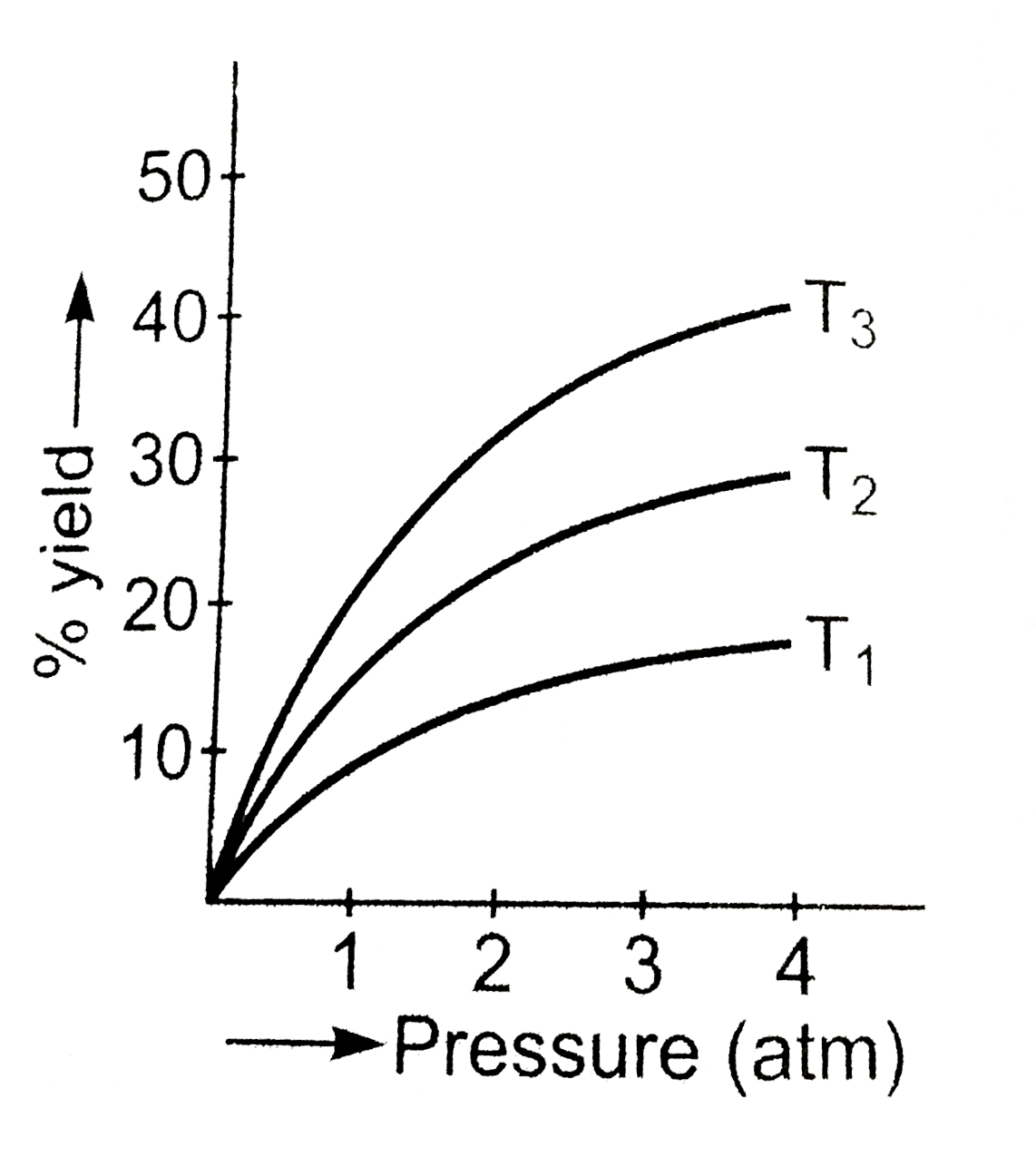The pressure inside the chamber is atm and temperature at
The preparation of ammonia by Haber's process is an exothermic reaction. If the preparation follows the following temperature-pressure relationship for its yield. Then for temperature and the correct option is:

A
B
C
D
none of these
Video Solution
Text Solution
The correct Answer is:B
Reaction is exothermic, hence, the reaction will shift in forward direction to give better yield.
|
Updated on:21/07/2023
Related Playlists
- BOOK - OP TANDONCHAPTER - MISCELLANEOUS (TOPICS OF GENERAL INTEREST)EXERCISE - SET-V: Matching type Questions37videos
MISCELLANEOUS (TOPICS OF GENERAL INTEREST)
- BOOK - OP TANDONCHAPTER - INTRODUCTION TO ORGANIC CHEMISTRY EXERCISE - SINGLE INTEGER ANSWER TYPE4videos
INTRODUCTION TO ORGANIC CHEMISTRY
- BOOK - OP TANDONCHAPTER - OXIDATION AND REDUCTION (REDOX REACTIONS)EXERCISE - SECTION V3videos
OXIDATION AND REDUCTION (REDOX REACTIONS)
Knowledge Check
- Question 1 - Select One
The preparation of ammonia by Haber's process is an exothermic reaction. If the process follows the following temperature pressure relationship for its % yield, then for temperatures T1,T2,andT3 the correct option is
 AT3>T2>T1BT1>T2>T3CT1=T2=T3Dnothing could be predicted.
AT3>T2>T1BT1>T2>T3CT1=T2=T3Dnothing could be predicted. - Question 1 - Select One
N2(g)+3H2(g)⇔2NH3(g),ΔHɵ=−22.4kJ
The pressure inside the chamber is 100 atm and temperature at 300K
On adding catalyst the equilibrium of reaction:AShift in backward directionBShift in forward directionCDoes not affect the equilibriumDCannot predict. - Question 1 - Select One
The prepation of SO3(g) by reaction SO2(g)+12O2(g)⇔SO3(g) is an exothermic reaction .If the preparation follows the following temperature -pressure relationship for % yield , then for temperatures T1,T2andT3 the correct option is:
 AT3>T2>T1BT1>T2>T3CT1=T2=T3DNothing could be predicated about temperature though given information
AT3>T2>T1BT1>T2>T3CT1=T2=T3DNothing could be predicated about temperature though given information - Question 1 - Select One or More
N2(g)+3H2(g)⇔2NH3(g),ΔHɵ=−22.4kJ
The pressure inside the chamber is 100 atm and temperature at 300K
If Kp for the given reaction is 1.44×10−5, then the value of Kc will be:A1.44×10−5(0.082×500)−2molL−1B1.44×10−5(8.314×200)−2molL−1C1.44×10−5(0.082×700)2molL−1D1.44×10−5(0.082×300)−2molL−1 - Question 1 - Select One
N2(g)+3H2(g)⇔2NH3(g),ΔHɵ=−22.4kJ
The pressure inside the chamber is 100 atm and temperature at 300K
If Kp for the reaction is 1.44×10−5, then the value of Kp for the decomposition of NH3
2NH3(g)⇔N2(g)+3H2(g)
will be:A√1.44×10−5B(1.44×10−5)4C11.44×10−5D1.00×10−3 - Question 1 - Select One
N2(g)+3H2(g)⇔2NH3(g),ΔHɵ=−22.4kJ
The pressure inside the chamber is 100 atm and temperature at 300K
30LH2(g) and 30LN2(g) were taken for the reaction in Haber's process which yields only 50% of the expected ammonia due to reversibility of the reaction. What will be the composition of reaction mixture under the given condition?ANH3=20L,N2=20L,H2=20LBNH3=10L,N2=25L,H2=15LCNH3=20L,N2=10L,H2=30LDNH3=20L,N2=25L,H2=15L - Question 1 - Select One
N2(g)+3H2(g)Fe+Mo⇐==⇒2NH3(g), Haber's process, Mo is used as:
Aa catalystBa catalytic promoterCan oxidising agentDas a catalytic poison. - Question 1 - Select One
For the reaction : N2(g)+3H2(g)⇔2NH3(g), ΔH=−ve, the correct statement is :
Aaddition of catalyst does not change Kp but changes ΔHBat equilibrium, 2GNH3=GN2+3HH2 (G is Gibbs' energy)Cat higher temperature, the rate of forward and backward reaction increases by a factor 2.Dat 400K, addition of catalyst increases rate of forward reaction by 2× and backward by 1.7×. - Question 1 - Select One
In reaction N2(g)+3H2(g)⇔2NH3(g),ΔH=−93.6kJ/mole, the yield of ammonia does not increase when
APressure is increasedBTemperature is loweredCPressure is loweredDVolume of the reaction vessel is decreased - Question 1 - Select One
For the chemical reaction
N2(g)+3H2(g)⇔2NH3(g)
The correct option is:A−13d[H2]dt=−12d[NH3]dtB−d[N2]dt=2d[NH3]dtC−d[N2]dt=12d[NH3]dtD3d[H2]dt=2d[NH2]dt

